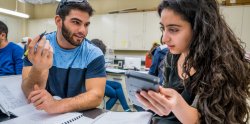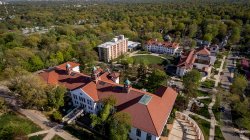Montclair State University will embrace and fulfill its identity as a Carnegie R2 doctoral and New Jersey public research institution, expanding both its national and international research impact, enhancing its research portfolio and reputation, driving innovation and relevant solutions for the social, economic, educational and health care challenges of the culturally diverse communities of New Jersey and the region.
Objective 3.1
Improve and upgrade business processes, facilities and technological resources in support of research.
Strategies
a) Form a Research Task Force to identify and implement best practices across all aspects of research in the institution such as cost allocations, infrastructure, grants administration, policy, and protocols
b) Form a Student Research Advisory Group to support and encourage diverse undergraduate and graduate students involvement in research
c) Establish a Scholarly Communication Center in the Library which would leverage our Digital Commons and facilitate access to scientific journals, research databases, and sci-finder tools
d) Cultivate a research-active graduate student educational culture
e) Continue development of relationships and partnerships with other institutions and professional bodies that support research
Success Measures
3.1.1. Inefficient business processes that negatively affect research administration and operations have been identified and eliminated
3.1.2. Research facilities have met the necessary requirements of current faculty for active and productive scholarship
3.1.3. Current technology supports 95% of all faculty research agendas
3.1.4. Increase the number of students who participate in faculty research activities by 50%

Objective 3.2
Increase external funding for research.
Strategies
a) Organize and prepare Ready Respond Teams (RRTs) of researchers with interactive expertise who will be able to respond efficiently to multidisciplinary RFPs
b) ORSP will join the Grant Resource Center in Washington, D.C. (and similar “ear-to-the-ground” organizations) to increase awareness of and prompt access to extramural sources of federal funding for research
c) Extend consulting and writing support for grants to all Colleges and Schools where potential for successful proposals is demonstrated
d) Assure that internal research funding is awarded to the most prepared and effective applicants, who will be most likely to convert this seed funding to successful external proposals
e) Expand activities for training/mentoring between junior/senior research faculty
f) Fund “pump-priming” internal research grants, offer summer grant writing workshops, and provide state-of-the-art activities/resources to develop successful grant writing skills
g) Engage the Office of Development to source private funding from corporations and other sources who will support innovative ideas for faculty research and programs
Success Measures
3.2.1. Increase the number of research grant proposals submitted by faculty 10% per year over a baseline established in FY19
3.2.2. Increased number of funding sources supporting research at the University over the baseline number of sources in FY19
3.2.3. Increased number of research grants funded by the federal government by 20% over the baseline established in FY19
3.2.4. Increased corporate and foundation funding for research from the baseline of FY19
3.2.5. Increased total external funding for research from the baseline of $18.4m to $22.0m
3.2.6. Increase state and nationally funded multi-institutional research collaborations by 10% over the baseline of FY19
3.2.7. Increased success rate of grant proposals submitted by faculty members at all levels

Objective 3.3
Expand and enhance the reputation and impact of University research.
Strategies
a) Improve the media reporting and recognition of both faculty and student scholarship
b) Fully populate and deploy Digital Commons and Research with NJ to propagate and broadcast more widely the scholarly productivity of the faculty and students
c) Broaden scope of research partnerships nationally and globally
d) Increase faculty participation in scholarly experiences, including faculty exchanges, international awards, and leadership positions in panels, and professional groups and professional societies
e) Launch a robust research communication program in print and online to convey the University’s strengths and accomplishments in research, scholarship and creative activity
Success Measures
3.3.1. Increased faculty peer-reviewed publications in higher quality journals and well-regarded scholarly presses
3.3.2. Demonstrated increase in the impact of faculty research and publications using standard quality metrics such as download counts, h-factor indices, citation counts, alt-impact, ResearchGate rankings, book reviews in high profile venues, etc.
3.3.3. Student researchers will be recognized by regional and national awards for scholarship
3.3.4. Montclair State University programs are ranked successively higher each year in valid and mission-appropriate national ranking systems
3.3.5. Faculty are recognized with increased awards from professional associations, leadership roles in those associations, and significant public distinctions
3.3.6. Improved awareness and favorable perceptions among key audiences of the University’s accomplishments in research, scholarship and creative activity over FY2109 benchmarks, as seen in positive earned news stories; web site and social media responses; downloads, citations and reviews of faculty scholarship
